Clematis Taiga is one of the most beloved varieties
Clematis Taiga, bred by Japanese breeders, took part in the Plantarium 2016 flower exhibition and won silver. The new variety with multi-colored and complex buds is unpretentious in cultivation and has an average degree of frost resistance. Consider the main characteristic of a perennial, as well as the rules for planting and caring for it.
- Characteristic
- Landing features
- Timing
- Place and soil
- Seedling preparation
- Planting technology
- Care rules
- Watering
- Loosening and mulching
- Top dressing
- Pruning
- Preparing for winter
- Reproduction methods
- Stem layering
- By dividing the rhizome
- Cuttings
- Diseases and pests
- Fusarium
- Wilt (wilting)
- Rust
- Powdery mildew
- Gray rot
- Aphid
- Medvedka
- Spider mite
- Nematode
- How to use it in the garden
- Gardeners reviews
- Useful videos
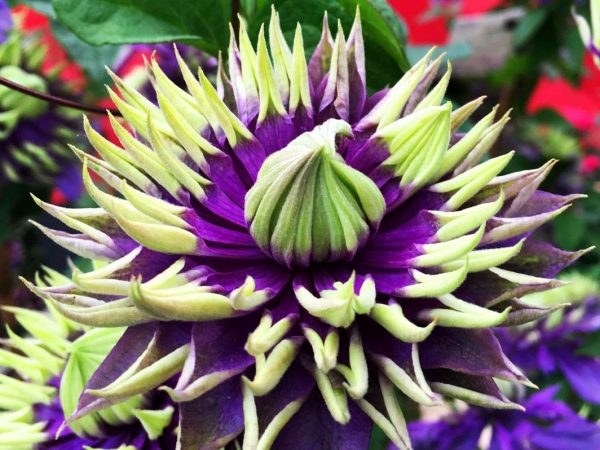
Clematis taiga
Characteristic
The Latin name is clematis taiga. Family - Buttercup.
The Taiga hybrid has an average frost resistance - suitable for cultivation in areas where frost resistance is not higher than level 6 (it safely tolerates a decrease to -23 ° C). These are areas with subtropical and continental climates. At lower temperatures, the plant freezes quickly.
In winter, when the indicators are not lower than -15 ° C, adult clematis do not cover. Bushes up to three years old need insulation.
The medium-sized liana-shaped bush is distinguished by its rapid growth - in a year the shoots stretch by 20-30 cm.The maximum height is 2-2.5 m, the crown diameter is 1 m.
Clematis pleases with double buds from the first days of June to mid-September. Inflorescences reach 12-15 cm in circumference.
At the beginning of flowering, the extreme and largest petals of a lilac-violet hue bloom, then smaller ones close to the center open - they are purple with variegated tips of a lemon shade. The core is deep yellow.
Leaves are emerald, with smooth edges, elliptical, cordate or trifoliate.
Landing features
As practice shows, the successful cultivation of this crop largely depends on the quality of the planting material, the composition of the soil and the correctly selected place on the site.
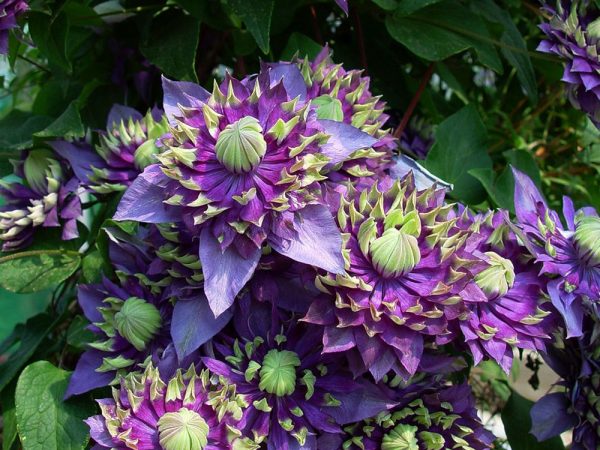
clematis taiga description
Timing
The best time to plant is mid to late April. By this time, the soil will warm up to 10-12 ° C, the air temperature will stabilize at 14-15 ° C. The risk of freezing bushes is minimal.
In regions with a warm climate, where summer is long and autumn is warm, it can be planted until the last decade of September. 1-1.5 months is enough for seedlings to adapt and prepare for the upcoming wintering.
Place and soil
Clematis need to provide quality lighting in the morning and evening hours. When planted in the open sun, the color can quickly fade, so shading will be required. The best place would be a plot on the southwest or southeast side.
The plant should be planted at a distance of 50 cm from the walls of the house, gazebo, fence or terrace. So the root system will fully develop, and the crown will be in the shade at noon.
The soil should be loose, drained, enriched with organic and mineral preparations.Look for a place with a neutral acidity level. If this is not possible, it is worth adding a deoxidizer - 400 g of dolomite flour, calcite, chalk or hydrated lime per 1 m².
The flower prefers to grow on loam. If the soil is heavy, its structure is improved by any loosening agent - sand, vermiculite or perlite (20 kg / m²). It is not advisable to plant in a place with a surface occurrence of groundwater, where the root system will quickly rot and the shrub will die. The optimum depth is 2 m.
On the site, all last year's vegetation, garden debris are removed, then dug up and leveled.
Seedling preparation
You can purchase planting material in a specialized nursery, where you will most likely be provided with a real variety.
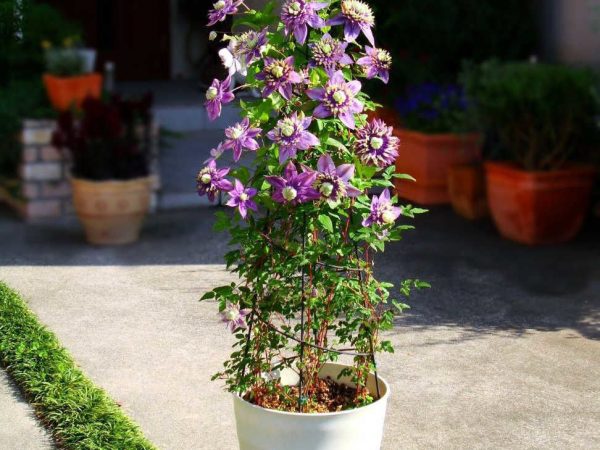
Photo of clematis taiga
If you choose, it is better to stay on a seedling 2-3 years old with a closed root system - it tolerates the transplantation procedure better and takes root faster than a bush with open roots.
Carefully inspect the crown - it must be fresh, the leaves are juicy, green, and do not crumble. The shoots are flexible, without mechanical injuries and signs of infection with diseases.
2 days before planting, clematis is kept in a cool and dark room at a temperature of 2 ° C. After this time, the root system is soaked in cold water for two hours, then cut to 2-3 cm in length. So the vine will begin to release new roots faster after planting in the garden.
Planting technology
Pits are dug out two weeks before planting, so that all the embedded components have time to settle. Approximate parameters - 60x60 cm. In group cultivation, keep a distance of at least 1 m, so the seedlings will fully develop and there will be no competition for moisture and nutrients.
The landing algorithm is as follows:
- drainage - pebbles, gravel, screenings or brick chips are poured onto the bottom of the holes (10 cm deep);
- a fertile composition is poured on top - a bucket of coarse sand, 10 kg of humus, 5 kg of peat, 200 g of ash, 100 g of superphosphate and 80 g of potassium sulfate are mixed;
- the soil mixture is trampled down, a deepening is made in the center, the rhizome is lowered, voids are sprinkled, compacted;
- after planting, watered (2 buckets of water), then mulched with sawdust or crushed bark;
- tie up shoots to a support;
- so that in the first weeks clematis does not dry out, it is shaded with agrofibre or burlap.
Depending on the type of planting material, the planting depth will be different:
- in a bush with lignified branches, it is recommended to immerse the basal neck to 10-12 cm, so that in the future the plant will bush well;
- if you have a seedling with green shoots, then you do not need to deepen this part, since it can quickly rot and the vine will die.
Care rules
Watering
This is a moisture-loving vine, but it does not tolerate regular overflows, therefore it is watered often, but moderately - as the soil dries up to a depth of 5-6 cm. You should also take into account the amount of precipitation - in a rainy summer, watering can be completely excluded.
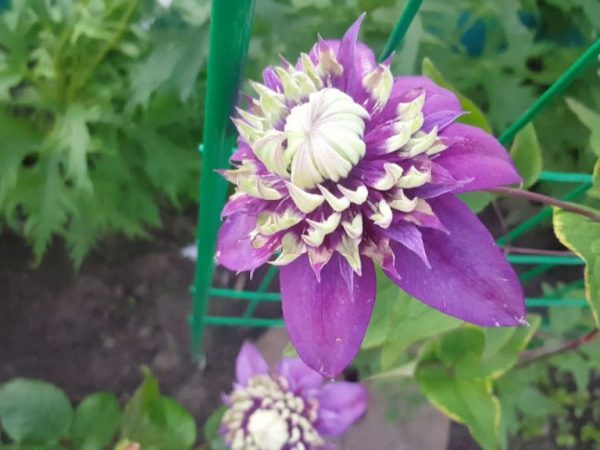
Clematis taiga variety description
In the first month, the seedlings are moistened every day so that they take root and grow faster. 20-25 liters of water are poured under one bush.
Obligatory procedures: at the beginning of the growing season, before flowering, after its end and in late autumn, when the shrub will throw off all the foliage.
Use warm and settled water to prevent hypothermia of the roots.
Loosening and mulching
Regular loosening of the soil one day after watering provides good moisture and oxygen access to the roots. In order to avoid the appearance of parasites and infections, it is necessary to keep the flower garden clean - remove weeds in time, weed between the bushes.
After these manipulations, mulch from peat, sawdust is introduced into the trunk circle, which protect the soil from rapid drying out.
Top dressing
In the first two years of development, clematis taiga does not need nutrients, it has enough of those that were laid during planting.After this time, organic and mineral fertilizers are applied several times per season:
- in early spring, before bud break, spill with a solution of urea or ammonium nitrate - dissolve 15 g of the substance in a bucket of water;
- before flowering, fertilize with a liquid top dressing of superphosphate and potassium sulfate - 1 tbsp. l. for 10 liters of water;
- with the same composition, you can shed a bush after the buds have dried;
- the last nutrition is necessary in the fall, when the bush sheds its leaves - sprinkle the tree trunk with compost or last year's manure (10 kg per 1 m²).
Fertilizers are carried out with watering, which improves the quality of assimilation of nutrients and prevents burns on the roots.
Pruning
This variety belongs to group 3, therefore, it needs a cardinal haircut to maintain decorative qualities and immunity against diseases.
In the first year of cultivation, the branches are cut to 30 cm above strong buds, in the next season - 10 cm higher, subsequent manipulations consist in cutting off the shoots so that the height of the aboveground part is no more than 80 cm.In addition, dried, broken off, damaged by frost and diseases are cut out branches on the ring.
Haircuts are carried out in early spring and late autumn. In the summer season, at the peak of decorativeness, it is necessary to monitor the state of the buds - wilted and shrunken ones must be cut. This will help prolong the flowering period and speed up the process of planting new inflorescences.
In addition to pruning, you should regularly tie the twigs in the right direction in order to get a compact, dense and beautiful crown as a result.
Preparing for winter
When grown in regions with a harsh climate, all clematis need insulation, regardless of age. After the autumn pruning on the eve of stable cold weather, the trunk circle is mulched with a thick layer of tree bark, straw, fallen leaves or peat. The branches are removed from the supports, bent to the ground, fixed with staples or hairpins, spruce branches are laid on top.
In warm areas, where the temperature does not fall below -15 ° C, only young bushes are sheltered, adults spud and leave them open for the winter.
Reproduction methods
You can propagate this shrub yourself in three ways, in which you get strong seedlings with all the varietal characteristics of the mother plant.
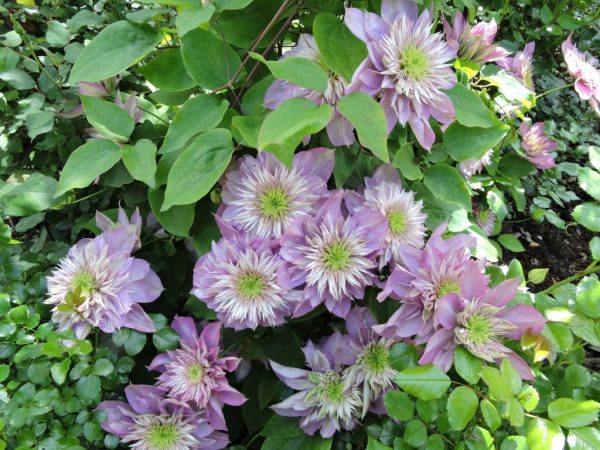
Clematis hybrid taiga
Stem layering
In the fall, when the vine sheds all the leaves, a flexible, long and lignified shoot is chosen on it, close to the soil. Nearby, a groove 5-6 cm deep is pulled out. The twig is lowered in a horizontal position, pinned with staples, covered with a fertile soil mixture of peat, sand and humus (1: 1: 1), watered.
Closer to the first autumn frosts, they are sprinkled with fallen leaves and sawdust so that the layers do not freeze over the winter.
In the spring, when the heat of the street stabilizes, the branch is dug up, cut off from the bush, and divided into several parts so that each one has roots. Then they are seated separately in the garden.
By dividing the rhizome
This method is advisable for old bushes or vines with damaged roots.
The breeding technology is simple:
- clematis is watered abundantly, after an hour they are dug in and carefully removed;
- together with the earth, they are placed in a basin of water to wash off the remnants of the soil;
- dried, if there is rot, cut out to healthy tissue, dipped for an hour in a fungicide solution;
- using a sharp tool, cut the rhizome into pieces;
- for successful rooting, each delenka must have roots and at least one branch with 2-3 buds;
- places of cuts are sprinkled with wood ash, planted in the same way as purchased seedlings.
Cuttings
Harvesting of planting material is carried out in spring or summer. Green shoots of the current year have the best survival rate. They are cut from the top of the stems at a height of 15-20 cm and always have two internodes and several buds.
In the lower part, the cuttings are completely freed from foliage, in the upper part they are cut to half the length. Immersed in Kornevin's solution for an hour. Then they are planted in a mixture of peat and sand mixed in equal amounts. Embedding depth - 3-4 cm.
The seedlings are watered, covered with a transparent film, aired every day. After about 2-3 weeks, new buds will appear on them, later the leaves are a sign that they have successfully rooted and the shelter can be removed.
Young plants continue to grow for another month so that they build up a strong root system, then they are transplanted to the site.
Diseases and pests
The description of the hybrid clematis Taiga includes a high resistance to disease, but if the rules of care and maintenance are violated, it is susceptible to various infections and pests.
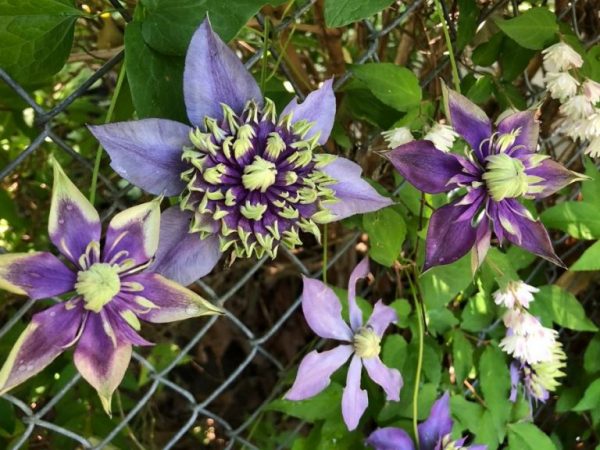
Clematis taiga photo and description
Fusarium
This sore develops in conditions of high humidity and frequent waterlogging of the soil. The leaves turn yellow, wither and dry. The disease is incurable, so the bush is dug up, disposed of, and the ground is disinfected with a fungicide.
Wilt (wilting)
A dangerous disease that, in a short period of time, leads to the complete wilting of stems and foliage. In conditions of elevated temperatures, the infection rapidly spreads to healthy shrubs.
It is not subject to treatment, therefore, at the first symptoms, the diseased vine is dug up and burned, and the place of its growth is spilled with a solution of copper sulfate.
Rust
The main symptoms are the appearance of red or brown growths on the surface of leaves and shoots. Infected areas begin to dry out and die off. In the treatment, Bordeaux liquid, Ridomil gold or copper sulfate are used.
Powdery mildew
A fungal infection occurs during a period of high humidity during the rainy season. Signs - a whitish oily coating on foliage and flowers. Over time, the affected areas darken, die off, the shrub stops growing and withers.
First, diseased organs are cut out, then the crown is irrigated with Topaz, Baktofit, Purest flowers, Fitosporin-M or a solution of colloidal sulfur (40 g per 10 l of water).
Gray rot
Symptoms are brown, shapeless spots on the foliage, later covered with a grayish bloom. Cut out the damaged parts, spray the shrub with Gamair, Fundazol or 2% Azocene solution.
Aphid
Green small insects settle in colonies on the inner side of the leaves, feed on their sap, which leads to wrinkling, drying out and falling off.
At an early stage of infection, you can do without chemistry - treat the crown with an ash and soap solution, infusion of onions, garlic, tobacco, or based on orange peels.
If this does not help, they resort to pesticides - they are treated with Karbofos, Fitoverm or Akarin.
Medvedka
Affects the root system of clematis.
Different methods are used in the fight:
- At a distance of 50 cm from the near-trunk zone, heaps of manure are laid out. After 2-3 days, the parasites accumulated in them are destroyed.
- Pour sunflower oil into the holes that the insect makes.
- Dig several cans or bottles filled with beer into the ground. The containers are installed at an angle of 45 ° so that the bear has the opportunity to climb into it.
Spider mite
It is a sucking parasite that cobwebs the underside of the leaves with small cobwebs. Over time, the foliage turns yellow, covered with a marble pattern. In the fight against the pest, Actellik or Aktara is used.
Nematode
It affects the root system, clogs blood vessels and blocks access to moisture and oxygen. Because of this, the crown begins to rapidly wither, turn yellow, the shrub dries out.
Getting rid of parasites is difficult, so it is easier to dig up the vine and dispose of it. The place of its growth is spilled with boiling water, copper sulfate or a raspberry solution of potassium permanganate.
How to use it in the garden
A perennial vine with large double flowers is in great demand in modern landscape design:
- used as a tapeworm;
- planted in groups along fences, nearby walls of a house or farm buildings, creating a thick and bright hedge;
- combine with other varieties of clematis to get a multi-colored composition;
- grown together with low-growing flowers - marigolds, calendula, mint, primrose, as well as decorative deciduous plants - hosta, juniper.
Gardeners reviews
Most gardeners have this variety in good standing and received many positive reviews:
- some fell in love with him for the unusual color of the inflorescences, which delight with beauty until autumn;
- others like that many new varietal seedlings can be grown from their own bush for landscaping the garden;
- due to successful growth, development in combination with other flowers and shrubs, clematis is used to create the most original and unique decorations on a personal plot.

